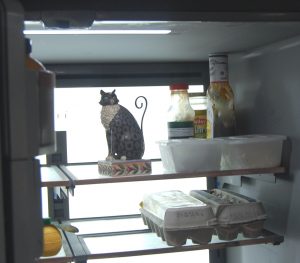In a previous post, I said that the Internet of Things (IoT) has increased the size and complexity of home networks. We had a new heating system installed recently that added a new dimension to our home IoT network: RedLINK ™, which, on the whole, was good for our home security.

IoT and network complexity
As networks increase in size and complexity, they become more difficult to manage and secure. Businesses hire technicians who are trained in security to manage their networks, which is usually a spendy proposition, but there is a lot at stake and security is one of many justifiable costs of doing business that accountants and managers prepare for.
Working from home network security
At home, we are in a different position. I’m not an accountant or a tax expert, so don’t take my word for it, but if your income is from a regular paycheck, the IRS probably will not allow you to deduct expenses derived from working at home. You might be able to convince your employer to reimburse you for these expenses, but be sure that the reimbursement will not be considered taxable income. In other words, in most cases, you secure your home network on your own nickel.
When I was working from home, most years, my employer, CA Technologies, permitted me a fixed amount on my expense account that I could request for working-from-home outlays. Not all employers do that, but take advantage if you can.
Since I retired and began writing books for extra income, I have deducted some for computing, network, and office overhead every year. I keep records of business expenses and have an accountant go over them to be sure they’ll pass an audit.
Home network security challenges
As a businessman, I don’t think I could justify investing much cash in our home network security. We are not juicy hacker bait. Although a successful attack could throw us in a world of hurt, it would not give a hacker much of a payday compared to even a moderately large business or agency.
Nevertheless, I worry about the security of our network. That means home network security is a DIY project for me. Fortunately, forty or so years in the computing industry has prepared me for this.
Securing HVAC
I’m working on methods to secure home networks that folks can do for themselves. In this post I will say something about securing home heating, ventilation, and air-conditioning systems (HVAC). This is an important topic for me because we just had a new heating system installed.
I was pleased to discover that our new system uses an alternative to standard Wi-Fi for communications. Sensors and controls connect wirelessly, but not the same way the rest of our computing gear connects.
IoT and Wi-Fi
Wi-Fi, the wireless network standard that almost every home network relies on, was designed with the capacity for data flows like streaming video, which is massive overbuilding for most IoT purposes. The data passing to and from IoT devices, with the exception of remote cameras and speakers, is typically miniscule compared to Wi-Fi loads.
There are several IoT platforms available that support low bandwidth communications. Our heating system uses the Honeywell RedLINK ™ platform specifically designed to support residential heating, ventilation, and air conditioning (HVAC) systems. It uses the 900 MHz band, which is a lower frequency than most Wi-Fi.
Lower frequencies have longer range and penetrate barriers like walls more easily than higher frequency signals. Thus, lower frequencies are more reliable and cover more area. The downside of lower frequency is lower data transfer rates, but for applications that don’t transmit a lot of data, like HVAC, lower data rates are fine.
A heating system that reports temperatures and humidity every 2 minutes from several sensors spread through a house is transmitting data at a trickle compared to streaming video, audio, and even sending a moderate size word-processing file. At 900 MHz, RedLINK ™ has better wall penetration and range than Bluetooth or typical Wi-Fi, which use 2.4 GHz and higher frequency bands. Even if Wi-Fi were unreliable in our house, I would expect RedLINK ™ to be solid.
Interference on the 900 MHz band
But the 900 MHz band is crowded. To begin, it’s designated for scientific, industrial, and medical device connectivity. Some cell phone and walkie-talkie type communications use it. Wireless telephone handsets often use the 900 MHz band. Amateur radio hobbyists also are permitted to use 900 MHz band signals. Consequently, in a residence, several devices might attempt to send a signal at the same frequency within the band at the same time. Colliding signals garble the message. This shows up as interference, which could be a big problem.
Frequency hopping
RedLINK ™, like Bluetooth, and the actress Hedy Lamar’s torpedo guidance system, has another trick: frequency hopping.
The military began to develop frequency hopping before WWI to protect battlefield radio messaging. By switching frequencies quickly in unison, the signal from transmitter to receiver never lingers long enough at a given frequency to degrade the overall message.
In addition, modern communication systems divide data into small chunks called packets that can be checked for consistency and resent if necessary. The combination of packet data and frequency hopping practically eliminates interference at low data volumes.

Changing frequencies also discourages interception and listening in on messages, but, unfortunately, the technology to follow most frequency hopping schemes is freely available now, so hopping is weak security, but it does effectively squelch interference on crowded bands.
Power consumption
The 900 MHz band consumes less power than higher frequency transmissions and batteries last longer. Since I don’t relish crawling into odd corners to change batteries on remote sensors, battery life is more important to me for IoT than other applications.
Proprietary protocol
A proprietary network protocol like RedLINK™ installs more easily and reliably than Wi-Fi for HVAC, but it tends to lock consumers into a single vendor. A version of the public Wi-Fi standard designed for low volume data transmission, called Wi-Fi HaLow, exists. But I haven’t found any HaLow equipment on the market.
Hacking RedLINK ™ could be devastating, essentially allowing a malicious invader to take over our heating system, making our lives uncomfortable, possibly wrecking our heating system, or setting our house on fire. I have no doubt that a diligent enough hacker could gain entrance to a RedLINK ™ network, but it would require detailed knowledge of a proprietary system, which would require a lot of effort for a low money skill.
A sigh of relief
In fact, I breathed a sigh of relief when I found that our thermostat doesn’t use Wi-Fi to communicate with our furnace. I am far more concerned with hacking our Wi-Fi system than RedLINK ™.
Issues remain
Our smart thermostat is attractive and easy to use because it’s a small but powerful computer. This has drawbacks. For example, I found instructions on the internet for running the video game Doom on a model similar to the thermostat in our dining room. I worked on an application twenty-five years ago to rid corporate networks of that very game.
It’s not as bad as it may appear, but rogue Doom installations bear some scrutiny, which I will do in a future post. More important, I have not enabled or begun to explore the app that connects a smartphone or other computer to the thermostat. This is a subject for a future post and an area for caution.




